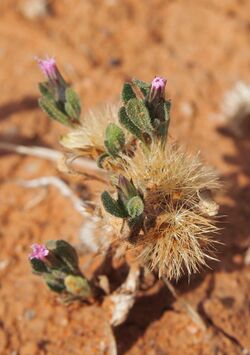Biology:Streptoglossa adscendens
| Desert daisy | |
|---|---|

| |
| Scientific classification | |
| Kingdom: | Plantae |
| Clade: | Tracheophytes |
| Clade: | Angiosperms |
| Clade: | Eudicots |
| Clade: | Asterids |
| Order: | Asterales |
| Family: | Asteraceae |
| Genus: | Streptoglossa |
| Species: | S. adscendens
|
| Binomial name | |
| Streptoglossa adscendens (Benth.) Dunlop[1]
| |
Streptoglossa adscendens, commonly known as desert daisy,[2] is a species of flowering plant in the family Asteraceae and grows in all mainland states of Australia with the exception of Victoria. It is a ground cover, upright or ascending perennial or annual herb with purple or pink flowers.
Description
Streptoglossa adscendens is a short-lived, leafy, many branched perennial or prostrate herb to 40 cm (16 in) high with faintly aromatic, glandular leaves and upright stems covered in soft, thin hairs. The leaves are oblong to lance shaped, rarely spoon shaped, 1–5 cm (0.39–1.97 in) long, 0.1–1.7 mm (0.0039–0.0669 in) wide, narrowing gradually at the base, margins smooth or toothed and ending in a point. The flowers are borne on a short peduncle or almost sessile usually in clusters near the apex of leafy branches, consisting of 20-40 pink florets, involucre 0.7–1.1 cm (0.28–0.43 in) long, enclosed by a distinctive whorl of 3 or 4 leaves 0.5–1.5 cm (0.20–0.59 in) long, bracts purplish or green, smooth or with soft hairs. Flowering occurs from March to October and the fruit is dry, one-seeded, ribbed, 2–3 mm (0.079–0.118 in) long and densely covered with silky, flattened hairs.[3][4][5]
Taxonomy and naming
Streptoglossa adscendens was first described George Bentham in Flora Australiensis as Pterigeron adscendens. In 1981 Clyde Robert Dunlop changed the name to Streptoglossa adscendens and the description was published in Journal of the Adelaide Botanic Garden.[5][6] The specific epithet (adscendens) means "ascending".[7]
Distribution and habitat
Desert daisy grows in a variety of habitats including granite hills and the edges of salt lakes in rocky, clay soils in all Australian mainland states other than Victoria.[2]
References
- ↑ "Streptoglossa adscendens". Australian Plant Census. https://biodiversity.org.au/nsl/services/apc-format/display/92476.
- ↑ 2.0 2.1 Porteners, M.F. "Streptoglossa adscendens". Royal Botanic Garden Sydney. http://www.flora.sa.gov.au/cgi-bin/speciesfacts_display.cgi?form=speciesfacts&name=Streptoglossa_adscendens.
- ↑ Dunlop, C.R; Orchard, A.E (1992). Flora of Australia 37 Asteraceae 1 (1st ed.). Canberra: ABRS. p. 428. ISBN 9781486304165.
- ↑ Spooner, Amanda. "Streptoglossa adscendens". Department of Biodiversity, Conservation and Attractions. https://florabase.dpaw.wa.gov.au/browse/profile/8234.
- ↑ 5.0 5.1 Dunlop, C.R (1981). "Streptoglossa adscendens". Journal of the Adelaide Botanic Garden 3 (2): 177. https://data.environment.sa.gov.au/Content/Publications/JABG03P167_Dunlop.pdf. Retrieved 18 June 2022.
- ↑ "Streptoglossa adscendens". Australian Plant Name Index. https://biodiversity.org.au/nsl/services/rest/instance/apni/51507.
- ↑ Sharr, Francis Aubi; George, Alex (2021). Western Australian Plant Names and Their Meanings (4th ed.). Kardinya, WA: Four Gables Press. p. 130. ISBN 9780958034180.
Wikidata ☰ Q15554445 entry
 |

